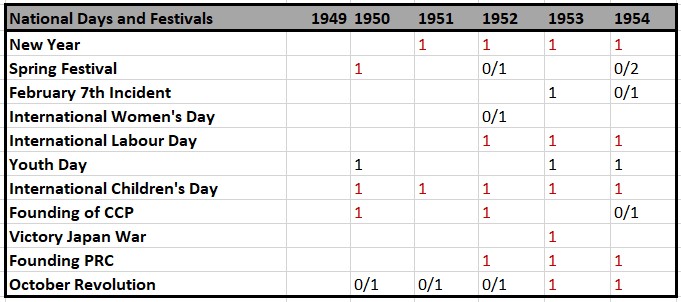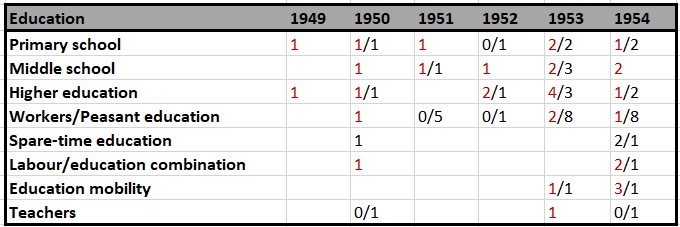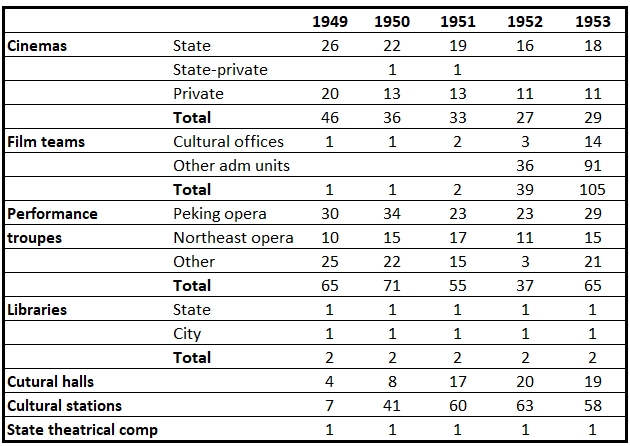Fig. 5.1 People's Daily Editorials
In the People's Daily dducation mobilty has titles like December 3, 1953 Organize Primary School Graduates to Participate in Agricultural Labor, or April 19, 1954 Get Well Prepared to Help 1954 Graduates of Middle and Primary Schools to Take Part in Production or Pursue Study in a Higher School
Fig. 5.2 People's Daily Editorials
 A Red Number indicates the subject was a major theme in the editorial. A Black Number indicates a minor theme in the editorial.
Source: Oksenberg (1982).
A Red Number indicates the subject was a major theme in the editorial. A Black Number indicates a minor theme in the editorial.
Source: Oksenberg (1982).
Fig. 5.3 People's Daily Editorials
A Red Number indicates the subject was a major theme in the editorial. A Black Number indicates a minor theme in the editorial.
Source: Oksenberg (1982).
Some films achieved significant success and popularity upon their release but were later subjected to extensive criticism. Socialist mainstream cinema was far from a uniform practice; it was a dynamic process of political and artistic experimentation that both defined and challenged the boundaries of a new national cinema.
Propaganda is at the first place aimed at:
(1) the masses of workers and peasants, who are regarded as natural supporters of the regime, (2) the remnants of formerly powerful social classes, most of whom are likely to remain enemies, (3) the youth in schools and armed forces who are relatively uncontaminated by the ideas of previous regimes and who can be educated in socialist doctrine, and (4) the Communist militants themselves, whose loyalty and techniques need constant strengthening. "
The most important theme of propaganda is
"The continuous drive toward technological and economic advancement furnishes a central theme for nearly all propaganda and indoctrination campaigns. Stepping up production is among the highest of Communist virtues. The campaigns are calculated to justify to the working people the production goals set by the regime and to arouse their zeal and enthusiasm. Labor discipline and the need for being content with poor working conditions require that the incentives offered for higher production be primarily psychological. The regime has not thus far provided adequate material stimuli to productivity; its emphasis upon the production of capital goods at the expense of consumer's goods has made this impossible, and hence appeals to the worker's loyalty and devotion are essential. "
Chin (2023) concludes
"The victimization narrative (the suffering inflicted by Japan and the United States) was deployed in the CCP’s anti-US propaganda during the Korean War, especially when the Chinese public had neither strong animosity against the previous ally nor strong confidence in the possibility of China’s victory over the United States."
In the first years of the PRC
"Socialism in the 1950s was fluid. Local implementation of central policies was flexible due to practical considerations. Cadres interpreted and implemented central policies locally, even personally, when contradictions appeared between the Party’s guidelines and local situations."
This often resulted
"...some state cultural institutions and enterprises continued to exhibit profit-minded behavior by focusing their efforts on maximizing attendance, rather than on correct propaganda and enforcement of high ideological standards among employees
Johnson (2018) suggests in his article that when exploring political culture through grassroots methods, we find that it's not solely or mainly composed of elite-approved cultural forms. Instead, local political culture, shaped by historical experiences, emerges as a diverse and unpredictable mix. This includes: 1) a combination of national and local official culture; 2) a quasi-official culture from producers not fully integrated into party-state hierarchies; 3) other cultural sources in tension with dominant state culture(s); and 4) officially produced or sanctioned culture that deviates from national policies (like "errors" or "mistakes").
While local official cultural institutions contribute to grassroots political culture, enduring folk traditions and iconoclastic beliefs persist as cultural sub-dimensions. The narrative of ever-increasing party-state legitimacy in PRC history seems questionable when viewed from a grassroots perspective. This perspective invites a more nuanced understanding of the historical phenomenon surrounding the production and reception of official political culture.
Fig. 5.4 Official estimate and classification of cultural enterprises, Beijing, 1949-1953.
Source: Johnson (2018). Page 18
Several of these institutions were holdovers from the city’s pre-1949 government, which had organized and funded popular education halls, vocational “mass schools” (民众学校), and book and newspaper reading rooms (阅书报处).
Under the CCP these sites were transformed into cultural halls, cultural
stations, and reading rooms.
Already during Japanese occupation and during the civil war, the CCP recognized the significance of graphic art
“and its ability to sway public opinion through forceful images… not only to comment on political as well as social developments but also, and more important, to portray visions of a new
society under Communist rule.”
Perry (2012) concludes
"The PRC propaganda system was patterned both institutionally and operationally on that of the Soviet Union. In contrast to the Bolsheviks, however, Mao and his comrades enjoyed the advantage of having tinkered with this system for nearly three decades prior to the establishment of a Communist party-state. The result,..., “Soviet models were never blindly followed, and, on many occasions,
they were either rejected by Chinese officials or appropriated for their own use." Compare this with Pepper (1990)
Article 43 .
Johnson (2015) observes
"...post- 1949 local cultural landscapes remained heterogeneous, even in the context of ongoing state expansion into previously unorganized leisure time or amidst efforts to export urban- produced cultural templates from city core to periphery and countryside"
and he continues
"Responsibility for managing local cultural activity fell to provincial and municipal, rather than county, governments, creating limitations on budgets and personnel available for the promotion of state culture in rural areas"
Cong (2016) notices also some obstacles
"For the CCP , the popular arts like Pingju and other local operas were very helpful in promoting its new policies. These arts had a broad audience among the lower social classes which were the targeted audience for the CCP social movements, and were strongly motivated to adopt revolutionary themes for social reform as they sought state recognition for their works. Nevertheless, in the eyes of the elites and the new state, the popular arts, such as xiangsheng , quyi and local operas , also had shortcomings because the performers and musicians, who were often illiterate or semi-literate..., had difficulty in understanding the political core of social reform and were thus not able to present the political themes well....Meanwhile, the vulgar taste and erotic content of their works also became a big obstacle to their consideration as high-class art and use in serving the idealistic goals of politics."
Hu (2012) lists the instruments the party has to reward and punish writers and other artists.
– The CCP monopolized all avenues for publication, thereby preempting opportunities for the publication of works that the Party disliked. – The CCP would in all cases carry out a severe persecution of authors
who had written so-called “reactionary” works, as soon as this was discovered. – The CCP would greatly commend the works of which it was fond
and would often bestow extremely handsome rewards of fame and profit on the writers of those works. – The CCP employed all of its propaganda tools to install its line and
viewpoint throughout the entire society, and explicitly proclaimed that Party ideology would guide all creative activities.
"...revolutionary and non-revolutionary cultures both confronted and compromised with each other: while the CCP sought to transform urban culture in order to consolidate its
rule, its efforts were thwarted by that very culture’s resiliency, and the CCP’s peasant cadres fell under the influence of urban culture when exposed to it. These examples reveal certain cultural continuities between the periods before and after the CCP takeover. Notwithstanding the enormous cultural change affected under the new regime, culture tends to
exhibit some autonomy, and even a powerful state like the PRC cannot alter this. In this sense, cultural continuity and rupture have always been
central themes in the process of socialist cultural transformation."
The CCP’s directives on thought remoulding are vague.
"This allowed local cadres greater leeway and initiative in carrying out campaigns, but it also reflected the competing objectives of the party’s various concurrent campaigns (in this case, national reconstruction and New Democracy, on the one hand, and Thought Reform, the Three Antis, and the Korean War, on the other). Yet, far from exhibiting patience, the Campaign to Suppress Counterrevolutionaries led to a preliminary round of arrests in universities and schools throughout China, including more than 4,700 teachers and staff (mostly in lower and middle schools) in the East China region by the end of 1951"
Fig. 5.5 People's Daily Editorials
A Red Number indicates the subject was a major theme in the editorial. A Black Number indicates a minor theme in the editorial.
Source: Oksenberg (1982).
The CCP considers the media division as an imperative tool to establish the new regime and an important instrument in the class struggle. Far ahead of other industries the publishing industry is transformed to a full state controlled sector. Volland (2003) expresses this point of view:
"The restructuring the Chinese publishing sector had taken little more than two years, from early 1949 to early 1951. The process had been far from linear; it had been riddled by protracted debates, misunderstandings, and breakdowns of communication. Overall, trial and error accompanied the experiments that in the end led to the emergence of a permanent structure for the Chinese publishing sector – not without, however, leading to significant disruptions of the industry’s functioning. The Party’s determination to accept these disruptions …as a transitory phenomenon attests to the conviction of the CCP leadership to follow the ideas outlined in the Party’s media concept..."
Shen (2019) concludes
"In brief, the ‘sport serves the people’ principle was not only a Marxist–Leninist cornerstone of the CCP’s ideology, but also
it reflected the implementation of Maoism in the superstructure to help the Party achieve hegemony."
Yeager (2021) observes
"As such, two significant conclusions can be drawn about the first two years of the PRC:
(1) the central government’s position was generally weak, and therefore reliant on genuine
support from intellectuals, and (2) state policies were typically designed to promote cooperation
rather than conflict with the intellectual class. Over time, the fragile alliance between the state
and the intellectuals would bend—although never break entirely—under the weight of mutual
suspicion and more aggressive state efforts at imposing controls on the thoughts and behaviors of
intellectuals. Nonetheless, events in 1950 and 1951 still set the tone for the rest of the decade.
Intellectuals found their voice and participated energetically in the processes of state-building.
The new society would belong to them just as much as it did the Communist Party."
Zhang (2010) remarks
"the CCP did not antagonize the newspapermen as
class enemies. Instead, within these rigorously controlled ideological regimes, the
party-state presented these elites with the promise of the new people’s democracy.
Although newspaper elites had reservations about the state-run media’s new rules
and regulations, and had to undergo the difficult process of thought reform, they
generally accepted the news-media industry, and made efforts to integrate into this
new infrastructure. Thus, the role that the new people’s democracy played in the
nationalization of the newspaper industry cannot be ignored.
Another important point is the relationship between the state and middle and
lower level employees. As noted above, the individuals most affected by thoughtreform
and the restructuring of the media industry were middle and lower level
employees. State officials put the weapon of democracy into these people’s hands
and encouraged them to push the great reporting and accusation campaign to its
height, only to drive the majority of those individuals out of the media industry.
"
Huang (2020) notices
"Both the Nationalists and Communists endeavored to draw newspeople over to their side and utilize
them to pursue their agenda. Meanwhile, the newspeople, as a group of intellectuals who actively
took part in the political and cultural construction of China, also tended to identify with certain
political powers and cooperate with them. Therefore, the relationship between the newspeople
and political powers were intertwined rather than antagonistic. "
Zhang (2020)
"...argues that the transition from supportive policies to restrictive ones was not abrupt but rather gradual and continuous and the frequent adjustments of policies demonstrate an adaptive nature based on the concrete historical situations. It also argues this transformation process led to relevant consequences, including the successful establishment of the state-run publishing industry, the re-distribution of the publishing businesses over the country, the intensification of the tendency of the politicization of the publishing industry and other subtle impacts on the culture, economy, and other aspects of China’s society in the next several decades."
Perry (2012). Page 155. Not only is the propaganda system built on Yan'an experiences but also on Imperial and GMD traditions.
[↩] [Cite]




